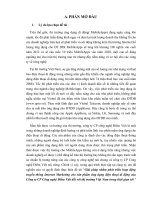phát triển chương trình tiếp thị xã hội cho sản phẩm bao cao su nữ, đối tượng gái mại dâm ở việt nam
Bạn đang xem bản rút gọn của tài liệu. Xem và tải ngay bản đầy đủ của tài liệu tại đây (1.47 MB, 122 trang )
VIETNAM NATIONAL UNIVERSITY, HANOI
SCHOOL OF BUSINESS
NGUYEN THI LAN HUONG
DEVELOPING SOCIAL MARKETING MIX
FOR FEMALE CONDOM TARGETING SEX WORKERS
IN VIETNAM
Major: Business Administration
Code: 60 34 05
MASTER OF BUSINESS ADMINISTRATION THESIS
Supervisor: Dr. Tran Doan Kim
Hanoi, 2012
ACKNOWLEDGEMENTS
I gratefully acknowledge the members of the target groups,
who participated in this study,
And especially surveyors, peer educators and project coordinators,
who helped to draft and carry out the interviews.
I am very grateful for the advice and comments of Dr. Tran Doan Kim,
who have whole-heartedly supervised and guided me to complete this thesis.
i
ABSTRACT
DEVELOPING SOCIAL MARKETING MIX
FOR FEMALE CONDOM TARGETING SEX WORKERS
IN VIETNAM
Nguyen Thi Lan Huong
MBA Candidate, 2008 - 2010
Hanoi School of business, Vietnam National University
Supervisor: Dr. Tran Doan Kim
December, 2012, 122 pages
In the mid-1980s, Condom Social Marketing (CSM) emerged as an effective
tool in combating the spread of HIV/AIDS. Through Social Marketing
programs and projects in many countries affected by the epidemic, condoms
have become more easily available, affordable and acceptable to sexually
active men, women and young people in general as well as to those in highrisk groups, including female sex workers. In Vietnam, unsafe commercial
sex is one of the primary drivers of the HIV epidemic. It is estimated that
9.3% of all female sex workers in Vietnam will be living with HIV in 2012.
In addition, and particularly in the case of condoms with Sex Workers (SWS),
social marketing can be an alternative source of products and information for
them who may be unable or unwilling to access public health services.
The female sex workers study design is based on theoretical framework of
Social Marketing Mix specially focus on P4: Promotion - Integrated
Marketing Communication; and the perform framework for social marketing
ii
(Chapman and Patel, 2004). Perform analyzes the major determinants of
health behaviors by categorizing them in terms of opportunity, ability and
motivational factors. By segmenting the customer and conducting formative
research, we will determine the exact needs and suitable and effective condom
social marketing. CSD‘s team target SWS in six provinces: Hanoi, Haiphong,
Quang Ninh, Ho Chi Minh, Can Tho and An Giang. We use an innovative
approach to conduct qualitative, exploratory research on the most relevant
methods of changing behavior among the various at-risk groups within the
SWS population. Data was collected via individual face-to-face interviews,
using a structured questionnaire.
Reported that SWS use condom with clients during the last sex was high
(91%), but consistent condom use in the past month was lower (66%). In the
past month, 83% of SWS report having regular clients and 71% report always
using a condom with these clients. 56% of SWS reported having noncommercial regular partners in the past three months. Reported condom usage
is much lower with non-commercial partners than with commercial partners.
At last sex, 39% of SWS report using a condom with regular partners and
25% report consistent condom use. The risk factor here is the risks of
HIV/AIDS with SWS though not consistent use any condom with their
partners (commercial and non-commercial clients).
In this situation with my knowledge had studied specialize in marketing at
HSB, I create the female condom social marketing communication campaign
for SWS in Vietnam with brand ―SHE female condom‖. My campaign focus
on SWS consistent use female condom with both their partners: commercial
clients and non-commercial sex partners.
iii
The marketing plan that has been prepared for the market analysis followed.
The thesis outlines the various factors that need to be considered in bringing
out such a product and the various advantages that it carries for the society. I
am interested in creating awareness about the product ―SHE female condom‖
and create enough interest in the mind of SWS to facilitate purchase of the
product.
The measure of success of this social marketing program is much more than
the volume of product sales achieved. Female condoms have never come to
Vietnam and they are totally new to most people here in Vietnam. Thus, the
idea of this communication is to non-distinguish the introduction of female
condom in general and SHE brand female condom. In Vietnam, when new
products were introduced first to the people, the brand name of the very first
product, or sometimes the most popular brand name of a type of products got
to be taken as the name. For example, in Vietnam, most people call motorbike
―HONDA‖, even when the bike is produced by YAMAHA; or they call
―Lavie‖ for any mineral water. The idea of the communication plan is to unify
the concept of female condom with SHE brand female condom.
Also, since the product should be of non-profitable aim, communication for
the product has to be unified or in-distinguished with communication for
STDS including HIV/AIDS prevention among SWS. Thus, female condoms
should be compared to other methods of STDS prevention as male condoms
but not to fight for victory with them. Instead the idea should be that female
SWS now can feel safer and even more equal when they can be more active to
use condoms (female condoms).
In conclusion, I focus on social marketing, and particularly the social
marketing mix of female condoms, as a key strategy in the fight against the
iv
global HIV/AIDS pandemic. In Vietnam, the population will find it difficult,
frequently impossible, to avail of the new products and increased protection.
The lessons to be learned from the past experience and experiments in male
condom social marketing in Vietnam and female condom in other countries
can help in making female condom campaign efficiency in future.
v
TÓM TẮT
PHÁT TRIỂN CHƯƠNG TRÌNH TIẾP THỊ XÃ HỘI CHO SẢN PHẨM
BAO CAO SU NỮ, ĐỐI TƯỢNG GÁI MẠI DÂM Ở VIỆT NAM
Nguyễn Thị Lan Hương
Trường Đại Học Quốc Gia Hà Nội
Khoa Quản Trị Kinh Doanh.
Hướng dẫn: Tiến sỹ. Trần Đoàn Kim.
Tháng 12 , 2012, 122 trang
Từ giữa thập niên 1980 , marketing xã hội về bao cao su (CSM) nổi lên như
một công cụ hiệu quả trong việc phòng và chống lại sự lây lan của
HIV/AIDS. Thông qua các chương trình marketing xã hội và các dự án ở
nhiều quốc gia bị ảnh hưởng bởi dịch bệnh HIV/AIDS, bao cao su đã trở nên
phổ biến, dễ dàng mua với giá cả phải chăng đối với những những có hành vi
quan hệ tình dục như đàn ông, phụ nữ và thanh thiếu niên nói chung cũng như
những người trong nhóm có nguy cơ cao, bao gồm cả những người hành nghề
mại dâm. Tại Việt Nam, mại dâm không an toàn là một trong các nguyên
nhân chính của đại dịch HIV/AIDS. Ước tính khoảng 9,3% gái mại dâm ở
Việt Nam sẽ ―sống chung‖ với HIV vào năm 2012. Như vậy, với việc sử dụng
bao cao su của những người hành nghề mại dâm (SWs), marketing xã hội có
thể là một cách cung cấp các sản phẩm và thông tin cho họ, những người có
thể là không muốn hoặc không thể sử dụng các dịch vụ y tế công cộng.
Nghiên cứu về gái mại dâm được tiến hành dựa trên khuôn khổ lý thuyết về
marketing xã hội tích hợp, đặc biệt tập trung vào P4: truyền thông/khuyến mãi
- các công cụ tiếp thị truyền thông tích hợp và thực hiện theo mô hình hiệu
vi
quả cho tiếp thị xã hội (mô hình PERForM - Chapman và Patel , 2004). Thực
hiện việc phân tích các yếu tố quyết định chính của hành vi ảnh hưởng tới sức
khỏe bằng cách phân loại chúng về khả năng, cơ hội và các yếu tố động lực.
Bằng cách phân chia các đối tượng và tiến hành nghiên cứu, tôi sẽ xác định
chính xác nhu cầu và xây dựng chương trình marketing xã hội về bao cao su
phù hợp và hiệu quả.
Nhóm nghiên cứu của công ty phi chính phủ CSD‘s (Công ty Nghiên cứu và
Truyền thông vì Sự phát triển bền vững) tập trung vào gái mại dâm ở sáu tỉnh
thành trên cả nước: Hà Nội, Hải Phòng, Quảng Ninh, Thành phố Hồ Chí
Minh, Cần Thơ và An Giang. Chúng tôi sử dụng cách tiếp cận sáng tạo và
mới mẻ để tiến hành đo đạc định lượng, định tính, nghiên cứu thăm dò về các
phương pháp phù hợp nhất để có thể thay đổi hành vi sử dụng bao cao su
trong các nhóm có nguy cơ lây bệnh khác nhau trong số những người hành
nghề mại dâm (SWS). Dữ liệu được thu thập thông qua các cuộc phỏng vấn
trực tiếp, riêng tư với từng cá nhân, bằng cách sử dụng một bảng câu hỏi về
các vấn đề chúng tôi quan tâm.
Báo cáo chỉ ra rằng gái mại dâm sử dụng bao cao su với khách hàng trong lần
quan hệ tình dục cuối cùng là cao (91%), nhưng sử dụng bao cao su phù hợp
trong tháng trước (thời điểm phỏng vấn) là thấp hơn (66%). Trong tháng đó,
83% gái mại dâm được phỏng vấn trả lời rằng họ có khách hàng thường
xuyên và chỉ có 71% số đó luôn luôn sử dụng bao cao su với các khách hàng.
56% gái mại dâm đươc phỏng vấn thừa nhận rằng họ có bạn tình (không phải
khách hàng) thường xuyên trong ít nhất 3 tháng trước. Và với nhóm bạn tình
đó, họ ít sử dụng bao cao su hơn là khi quan hệ với khách hàng. Trong lần
quan hệ gần nhất, chỉ 39% số gái mại dâm được hỏi là có sử dụng bao cao su
với bạn tình, và chỉ có 25% là sử dụng bao cao su phù hợp. Nguy cơ ở đây là,
gái mại dâm sẽ dễ dàng bị lây nhiễm HIV/AIDS nếu họ không sử dụng, hoặc
vii
sử dụng bao cao su không đúng cách, không phù hợp với ―đối tác‖ (khách
hàng và bạn tình).
Trong bối cảnh đó, với những kiến thức và hiểu biết tôi thu nhận được qua
quá trình đào tạo tại HSB, tôi xây dựng một chiến dịch marketing xã hội cho
sản phẩm bao cao su dành riêng cho nữ giới, đối tượng mục tiêu là gái mại
dâm với ―SHE‖. ―SHE‖ mang ý nghĩa là dành cho phụ nữ, bảo vệ phụ nữ, là
người bạn của phụ nữ. Chiến dịch của tôi tập trung chủ yếu vào việc hướng
dẫn, mang đến cho gái mại dâm điều kiện tiếp cận với một loại bao cao su
phù hợp cho họ, có thể sử dụng với cả khách hàng và bạn tình.
Chiến dịch này được xây dựng bởi những phân tích thị trường đã được tiến
hành. Luận án đưa ra các yếu tố khác nhau cần được xem xét trong việc đưa
ra sản phẩm trên và những ích lợi khác nhau mà nó mang lại cho xã hội. Tôi
mong muốn tạo được độ nhận biết về sản phẩm bao cao su dành cho nữ giới
―SHE‖ , nâng cao hiểu biết cũng như thúc đẩy gái mại dâm mua và sử dụng
sản phẩm này.
Hiệu quả của dự án này không chỉ nằm ở việc đo lường doanh thu của sản
phẩm. Bao cao su nữ chưa từng xuất hiện ở Việt Nam và là một sản phẩm hết
sức mới mẻ. Vì thế, ý tưởng của chiến dịch này là tạo ra sự nhất quán trong
tâm trí người tiêu dùng về bao cao su nữ và thương hiệu SHE. Ở Việt Nam,
khi một sản phẩm được tiếp cận với thị trường đầu tiên, thì tên của sản phẩm
tiên phong đó, đôi khi sẽ trở thành tên gọi của cả một dòng sản phẩm. Ví dụ,
đa phần mọi người gọi xe máy là ―Honda‖, kể cả đó là xe máy của Yamaha;
hoặc họ gọi ―Lavie‖ thay cho tên nhãn hiệu của mọi loại nước tinh khiết đóng
chai khác. Chiến dịch này, theo đó, mong muốn tạo ra được một xu hướng
tương tự.
viii
Ngoài ra, từ khi sản phẩm được xác định bán với mục đích phi lợi nhuận ,
viêc truyền thông cho sản phẩm đã được đồng nhất với việc tuyên truyền về
các bệnh lây truyền qua đường tình dục (STDs) bao gồm cả HIV/AIDS cho
gái mại dâm. Theo đó, bao cao su nữ có thể được so sánh với các phương
pháp phòng chống lây lan STDs khác như bao cao su nam nhưng không phải
để loại bỏ những phương pháp đó. Thay vào đó, có thể nghĩ rằng, gái mại
dâm có thể cảm thấy an toàn hơn, và thậm chí còn công bằng hơn khi họ có
thể chủ động bảo vệ mình nhiều hơn khi sử dụng bao cao su nữ.
Ở phần kết luận, tôi tập trung vào marketing xã hội, đặc biệt là marketing xã
hội về bao cao su nữ, như là một chiến lược then chốt để chống lại đại dịch
toàn cầu HIV/AIDS. Ở Việt nam, người dân thường khó tiếp cận sản phẩm,
để biết về những lợi ích của sản phẩm mới và nâng cao khả năng bảo vệ bản
thân trước những căn bệnh có thể lây lan. Những bài học được rút ra từ kinh
nghiệm quá khứ và thử nghiệm trong marketing xã hội về bao cao su nam ở
Việt Nam và về bao cao su nữ ở các nước khác có thể có ích cho việc thực
hiện hiệu quả chiến dịch này trong tương lai.
ix
TABLE OF CONTENTS
ACKNOWLEDGEMENTS ................................................................................................................ i
ABSTRACT ....................................................................................................................................... ii
TÓM TẮT ......................................................................................................................................... vi
TABLE OF CONTENTS ................................................................................................................... x
LIST OF ABBREVIATIONS .......................................................................................................... xii
INTRODUCTION ............................................................................................................................. 1
1. What is social marketing? .......................................................................................................... 1
2. How the social marketing change the behavior of their customers? .......................................... 2
3. Condom Social Marketing ......................................................................................................... 6
4. About Sex worker ...................................................................................................................... 7
5. Why Female Condoms? ............................................................................................................. 9
6. About our organizer: ................................................................................................................ 11
7. Objectives of the thesis: ........................................................................................................... 11
8. Scopes of the thesis: ................................................................................................................. 11
CHAPTER 1: THEORETICAL FRAMEWORK ............................................................................ 12
1.1 Social Marketing - Social Marketing Mix ............................................................................. 12
1.1.1 What is Social Marketing? .............................................................................................. 12
1.1.2 Social Marketing Vs. Commercial Marketing ................................................................ 13
1.1.3 The Social Marketing Approach ..................................................................................... 15
1.1.4 Diffusion of Innovation ................................................................................................... 16
1.1.5 Social Marketing Model .................................................................................................. 16
CHAPTER 2: RESEARCH METHODOLOGY AND FINDINGS ................................................ 28
2.1 About CSD ............................................................................................................................. 28
2.2 Problem Statement/Hypothesis: ............................................................................................. 29
2.2.1 How did I process to get in touch with SWs to survey?.................................................. 29
2.2.2 Research Question and Result ......................................................................................... 30
CHAPTER 3: MARKETING MIX FOR FEMALE CONDOM .................................................... 42
3.1 Formulation of thesis proposition: ......................................................................................... 42
3.2 About Female condom (FC)................................................................................................... 44
3.3 SWOT Analysis ..................................................................................................................... 44
x
3.4 Social Marketing Mix ............................................................................................................ 46
3.4.1 Product ............................................................................................................................ 47
3.4.3 Place ............................................................................................................................... 49
3.4.4 Promotion - Integrated Marketing Communication ....................................................... 51
CHAPTER 4: INTEGRATED MARKETING COMMUNICATIONSTRATEGY (IMC) ............ 53
4.1 Communication Purpose/Targets /Objectives of the Campaign ............................................ 53
4.1.1 Communication Purpose of the Campaign...................................................................... 53
4.1.2 Communication Targets of the Campaign ...................................................................... 53
4.2 Communication Concept:....................................................................................................... 54
4.3 The First Three Years Marketing Strategy ............................................................................. 55
4.3.1 Year 2012 – The new protected partner for women ........................................................ 55
4.3.2 Year 2013 – Do you have a SHE inside your handbag? ................................................. 55
4.3.3 Year 2014 – Do you have a friend named SHE? ............................................................ 56
4.4 Marketing tools: ..................................................................................................................... 56
4.4.1 Year 2012 – The new protected partner for women: SHE - Carexy ............................... 56
4.4.2 Year 2013 – Do you have a SHE inside your handbag? ................................................. 63
4.4.3 Year 2014: – Do you have a friend named SHE? ........................................................... 64
4.5 This is some promotional materials in points of sales of SHE Female Condom: .................. 64
CONCLUSION & RECOMMENDATION .................................................................................... 68
REFERENCES................................................................................................................................. 71
APPENDIX: RESEARCH QUESTION AND RESULT ................................................................ 72
xi
LIST OF ABBREVIATIONS
AIDS
Acquired immunodeficiency syndrome
BCC
Behavior Change Communication
CA
Community agent
CBD
Community-based distributor
CBO
Community-based organization
CBSM Community-based social marketing
CSM
Condom Social Marketing
DHMT District Health Management Team
EEs
Entertainment Establishments
FC
Female Condom
HIV
Human Immunodeficiency Virus
Information, Education and
Communication
IEC
International Non-Governmental
INGO
Organization
KAP
Knowledge, Attitude and Practice
NGO
Non-Governmental Organization
PSI
Population Services International
xii
SM
Social Marketing
STD
Sexually Transmitted Disease
STIs
Sexually Transmitted Infections
SWs
Sex Workers
VCT
Voluntary Counseling and Testing
xiii
INTRODUCTION
This part is beginning of this thesis. It will provide the overview about social
marketing, condom social marketing and our target customer, female sex
workers in Vietnam. This is necessary information to develop next chapters.
1. What is social marketing?
Social marketing was "born" as a discipline in the 1970s, when Philip Kotler
and Gerald Zaltman realized that the same marketing principles that Ire being
used to sell products to consumers could be used to "sell" ideas, attitudes and
behaviors. Kotler and Andreasen define social marketing as "differing from
other areas of marketing only with respect to the objectives of the marketer
and his or her organization. Social marketing seeks to influence social
behaviors not to benefit the marketer, but to benefit the target audience and
the general society."
―Social marketing‖ may be defined as the adaptation of commercial
marketing and sales concepts and techniques to the attainment of social goals.
It seeks to make health-related information, products and services easily
available and affordable to low- income populations and those at risk while at
the same time promoting the adoption of healthier behavior. In fact, it may be
said that the ultimate goal of social marketing is to effect healthy and
sustainable behavior change.
Social marketing has become increasingly popular among governments,
donors and NGOs (non-government organization) as an efficient and effective
means of addressing serious health issues in developing countries. It has its
roots in family planning but the concept is now applied across many fields in
public life and health, in both developed and developing countries, including
such areas as protection of the environment, campaigns against smoking and
1
alcohol abuse, and the prevention and care of HIV/AIDS... The use of social
marketing in response to the challenge of improving the sexual and
reproductive health of women and men in developing countries has attracted
particular attention.
The social marketing program appeared in Vietnam recently. Vietnam
Government also has an interest in this program. The non-governmental
organizations work together with many partners to make social marketing
program effectiveness, and profitable for Vietnamese citizens.
2. How the social marketing change the behavior of their customers?
This part presents an overview of the way social marketing change the
behavior of their customer through PERForM framework. Therefore, I will
have an overview of study design that provides the necessary background for
the research.
Theoretical PERForM Framework
The female Sex workers study design is based on PERForM framework for
social Marketing (Chapman and Patel, 2004). PERForM analyzes the major
determinants of health behaviors by categorizing them in terms of
opportunity, ability and motivational factors.
The framework has four levels that mirror the logical framework. The top
level consists of the goal of social marketing for any health promotion
intervention, namely improved health status and /or, for interventions relating
to coping with sickness or disability, quality of life.
The second level consists of the objectives of social marketing stated as
product or service use on the left side and or other risk-reducing behaviors
that do not involve the use of a product or service on the right side. The
2
adoption or maintenance of these behaviors in the presence of a given risk or
need for health services is causally antecedent to improving or maintaining
health and or quality of life.
The third level consists of the determinants of behavior summarized in terms
of opportunity, ability and motivation that may differ by population
characteristics such as age and sex.
The fourth level consists of the characteristics of the social marketing
intervention.
The framework describes the applications of market research survey in the
social marketing process.
Segmentation: At this stage of the social marketing process, the
omnibus survey measures opportunity, ability, and motivational
3
constructs that are theoretically and empirically associated with
behaviors known to be positively associated with health status and
quality of life among those with risk.
Opportunity is institutional or structural factors that influence an
individual‘s chance to perform a promoted behavior. Opportunity
behavioral determinants are mutable by the social marketing agency,
outside the control of the individual, and can be measured
objectively (i.e. measured responses typically not elicited from the
target individual) and subjectively (i.e. measured responses elicited
from the target individual).
These behavioral determinants are:
availability, brand appeal, brand attributes, quality of care, and social
norm.
Ability is an individual‘s skills or proficiencies needed to perform a
promoted behavior. Ability behavioral determinants are mutable by
the social marketing agency, are controllable by the individual, and
can be demonstrated (or have the potential to be seen) through some
action. These behavioral determinants can be measured objectively
(i.e. measured responses not elicited from the target individual) or
subjectively (i.e. measured responses elicited from the target
individual), or both. They are: knowledge; self efficacy; and social
support.
Motivation is an individual‘s arousal or desire to perform a promoted
behavior. Motivation factors are mutable by the social marketing
agency, are wholly within the control of the individual, and are not
demonstrable.
Motivation behavioral determinants can only be
measured subjectively (i.e. measured responses elicited from the
4
target individual), and they are: attitude, belief, intention, locus of
control, outcome expectation, subjective norm, threat (risk), and
willingness to pay.
Segmentation can be done at one or more levels. At a minimum,
populations are segmented using risk and behavioral measures,
permitting comparisons of those who behave healthily by those who
do not conditional upon expertly defined categories of risk, such as
sexual risk behavior. In addition, segmentation can be extended to
include cross tabulations by measures of opportunity, ability and
motivation.
Statistical models that permit the identification of
opportunity, ability and motivational differences between those who
behave and those who do not, given a set of population
characteristics, provide the most information for strategic, project
and marketing planning.
Monitoring: Quantitative research strategies are used to monitor
exposure to the social marketing intervention, changes in the known
determinants of behavior in terms of opportunity, ability and
motivation.
Evaluation:
- Effectiveness is defined as a casual association between the activities
level (social marketing interventions) and changes at outputs
(opportunity, ability and motivation), purpose (behavior) and or goal
level (health status and or quality of life), given need, and adjusting
for other influencers of behavior.
5
- Cost effectiveness is defined as the cost at the social marketing
interventions of producing a marginal change at goal, purpose and
outputs.
- A substitution effect is a negative, unintended impact in which one
behavior is increased, but use of an equally beneficial behavior is
decreased. In this CP, for example, policy makers seek to monitor a
specific type of substitution effect known as dis-inhibition in which
potentially a campaign aimed at increasing the use of condoms may
be found effective, but also results in a decrease in risk reducing
behavior such as abstinence or fidelity to one sexual partner.
A halo effect is a positive, unintended impact in which efforts to increase one
behavior also results in increases in other, positive behaviors.
3. Condom Social Marketing
In the mid-1980s, condom social marketing (CSM) emerged as an effective
tool in combating the spread of HIV/AIDS. Through social marketing
programs and projects in many countries are affected by the epidemic
condoms have become more easily available, affordable and acceptable to
sexually active men, women and young people in general as Ill as to those in
high-risk groups. Although the programs have generally focused on the
product, Behavior Change Communications (BCC) and Information,
Education and Communication (IEC) activities have significantly contributed
to raise awareness of the risks of infection and the means of prevention,
reaching people, governments and institutions in all sectors of public and
private life.
Condom social marketing programs have made condoms more accessible,
affordable and acceptable in many of the world‘s poorest countries.
6
It has been said that in the case of condoms social marketing has acted as a
―normalize‖ of the product, reducing the stigmas popularly attached to it. Until
recently in many developing countries, public access to condoms was difficult as
the product was often available only in pharmacies and health clinics and
generally thought to be more appropriate for use by and with commercial sex
workers. Now, thanks to years of persistent social marketing activities, condoms
in many countries are widely available from a variety of outlets, openly discussed
in public and in the media, and are seen by many, including many of those at high
risk of HIV infection, to be common household items.
The ―de-stigmatization‖ of condoms in many countries illustrates how social
marketing can help populations to overcome social and cultural resistance to
practicing effective prevention of STDs and HIV/AIDS.
4. About Sex worker
The term 'sex worker' refers to a wide array of people who sell sex, and who
work in a variety of environments. They include women, men and transgender
people and people who may work either full time or part time, in brothels, or
bars, on the street or from home for example. In this thesis, I only study about
female sex workers (referred to as SWs). SWs, along with other marginalized
groups such as men who have sex with men and injecting drug users, are
often labeled a 'high risk group' in the context of HIV and AIDS. Sex workers
are a marginalized and often criminalized population, and are therefore very
difficult to track and monitor. They can therefore be hard to reach with HIV
prevention programs.
It is clear that sex workers are at high risk of becoming infected with HIV.
Improving the situation will require greater efforts by governments, groups,
and individual members of society to help sex workers. It is particularly
7
important that sex workers gain access to HIV prevention and treatment
programs. Such programs not only save sex workers‘ lives; they can also help
to stem the wider impact that HIV is having on societies around the world.
In Vietnam, unsafe commercial sex is one of the primary drivers of the HIV
epidemic. It is estimated that 9.3% of all female sex workers in Viet Nam will
be living with HIV in 2012. Although sex work is illegal and labeled as a
―social evil‖, there are about 31,000 sex workers operating throughout the
country. Research by the UN in 2009 shows the HIV epidemic in Viet Nam is
still in a concentrated phase, with a high prevalence among most-at-risk
populations. Female sex workers have the third highest HIV prevalence as a
group, after injecting drug users, and men who have sex with men. Among
sex workers, HIV prevalence ranges from 5% and 20% (Source: IBBS 2009).
That rate is 20 times higher among sex workers who inject drugs, since they
face the dual risk of unsafe sexual practices and injecting drug use.
Sex workers are still facing many barriers in accessing the essential social and
health services they need. Some of these barriers are due to cost,
unavailability of services and lack of knowledge, but the biggest barriers are
stigma, discrimination and fear. They are often blamed, labeled and are
discriminated against. Many health workers often have a hostile attitude
towards sex workers, not respecting the confidentiality of their HIV status.
This makes many sex workers reluctant to seek health care services. In
addition, the concept of ―social evils‖ and the campaigns to ―clean the streets
of sex workers‖ have created an atmosphere in which HIV and AIDS
prevention activities have become difficult and sex work has been driven
further underground.
8
In addition, and particularly in the case of condoms with sex workers, social
marketing can be an alternative source of products and information for them
who may be unable or unwilling to access locations where privacy is too often
impaired. For instance, through social marketing condoms are widely
available in places where they routinely go, as opposed to reproductive health
clinics. I use condom social marketing as a sustainable and effective means to
empower the most at-risk populations to lead healthier lives, through
consistent condom use and safer sexual behaviors. It is able to engage private
sector channels for targeted condom distribution thereby diversifying
channels for HIV prevention and creating elements of sustainability in HIV
programs. Through social marketing programs and projects in Vietnam are
affected by the epidemic condoms have become more easily available,
affordable and acceptable to sexually active men and young people in general
as Ill as to those in high-risk groups.
The purpose of this study among sex workers (SWs, particular in women) was
to provide evidence to guide programming and for monitoring and
implementation of HIV Prevention Program. This survey among female sex
workers aimed to: 1) identify and describe segments of the population in
terms of condom use with male clients and non-commercial partners; 2)
identify behavioral determinants of the aforementioned behaviors; 3) apply
study findings to design the female condom social marketing.
5. Why Female Condoms?
For many years, experts and advocates called for a means of preventing
transmission which is under the power of women, especially with sex
workers. The female condom is the only new method of HIV protection to be
introduced since the epidemic began, and to date it is the only method of
9
protection that can be female- or receptive partner-initiated. It is an
empowering option for women and receptive partners and has direct and
indirect effects on the psychology of risk reduction. Researchers at Harvard‘s
Program on Negotiation have shown that one of the major obstacles to
successful negotiation is a perceived lack of options. The female condom
provides an alternative which can improve the likelihood of protecting against
STIs and enhance the ability of receptive partners to reach an agreement
acceptable to both partners. Often in these situations the client will ultimately
choose to use a male condom, but it is the nature of the negotiation which has
changed for the better. It was also noted that the availability of the female
condom has actually increased the income of sex workers, as they do not have
to turn away clients who refuse a male condom.
The female condom has been shown to increase overall rates of protected sex.
One of the major benefits is that it can be used in high risk situations when
using a male condom is not possible. Peer worker participants expressed this
advantage as critical to sex workers because the female condom can be used
with clients who are inebriated and unable or unwilling to use a male condom.
Studies have shown that the female condom is a cost-effective intervention,
both in terms of averting HIV infection and the need for treatment and care,
and when compared to other prevention alternatives. Economic modeling
research found that a well-designed female condom program can be very costeffective and even save money in the public sector.
The female condom is a perceived as a safe, fun choice. This novelty makes
it more appealing as a product and easier to market and promote. Many
participants articulated this factor as highly attractive to users and facilitating
10
advocacy with those who may decline to use male condoms, such as clients
and regular partners of sex workers.
6. About our organizer:
From January 2012, I‘ve been working as Marketing Executive for the
Vietnamese
Non-Governmental
Organization,
called
Research
and
Communication Centre for Sustainable Development (here in after referred to as
CSD) under the auspices of the Vietnam Union of Science and Technology
Associations (VUSTA). CSD specializes in the activities of social marketing
consultant; researches and operates communication projects, provides behavioral
education in order to improve the perception of community. In particular, I
provide distinguished solutions and aim for a great number of beneficiaries.
7. Objectives of the thesis:
This study aims at analyzing the situation, as much as possible information
were collected from interviews, survey with SWs to find out how to increase
aware of female condom in Vietnam especially in SWs use, then drawing
IMC campaign for improvement of the using female condom, as a key
strategy in the fight against the global HIV/AIDS pandemic in Vietnam.
8. Scopes of the thesis:
This study is written about social marketing mix, but in my opinion, the P4:
Promotion - Integrated Marketing Communication is the most important
factor so I almost focus on analyzing P4-IMC.
In this thesis, I propose research activities are conducted with the PSI, an
International Non-Governmental Organizations in Vietnam. Then I create the
female condom social marketing mix, focus on communication for SWs in
Vietnam with brand ―SHE Condom‖.
11









